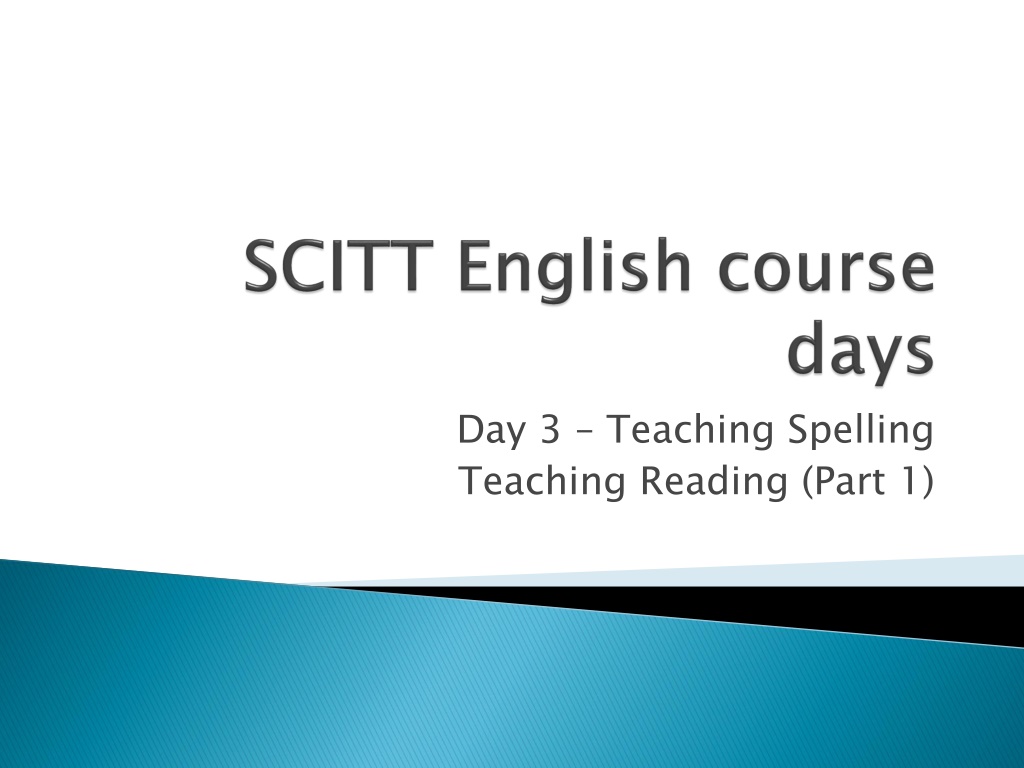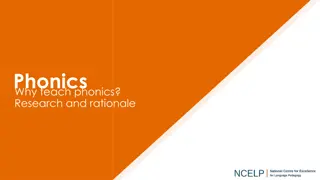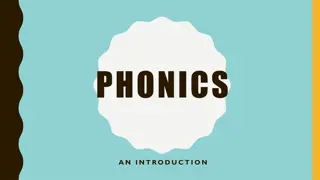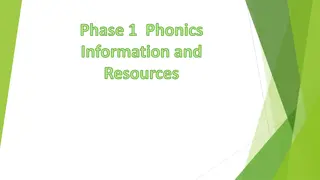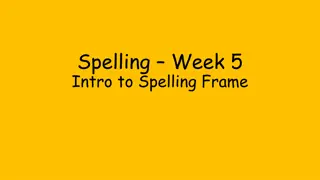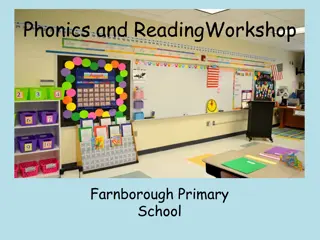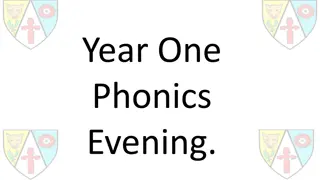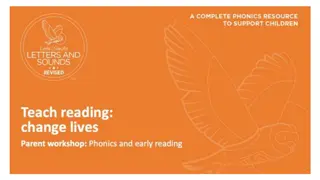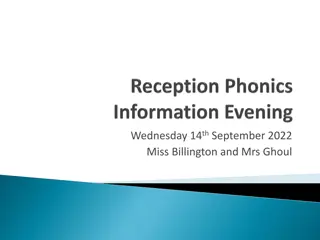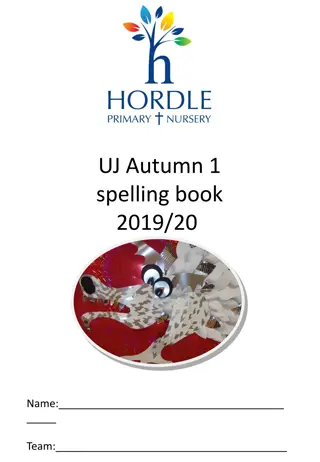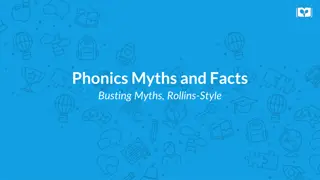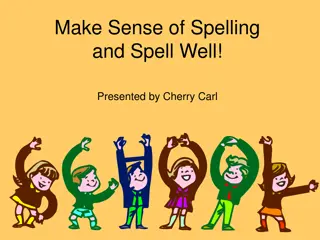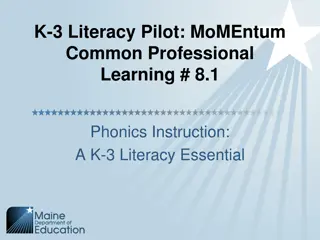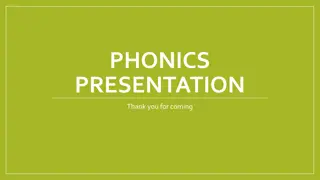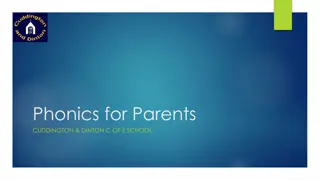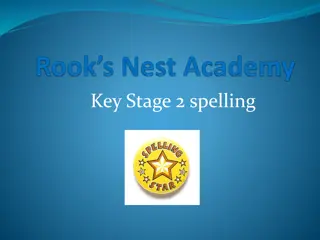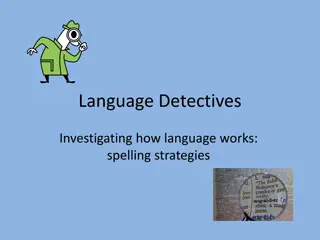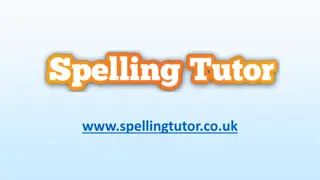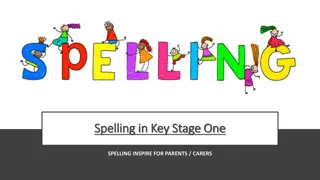Exploring Effective Phonics Teaching and Spelling Conventions through History
Explore the development of effective phonics teaching and spelling conventions through reflective logs and historical context. Discover the impact of phonics sessions on understanding and teaching practices, delving into Old English to modern-day practices. Learn about the evolution of language and spelling reform over the centuries, from Old English matching the Anglo-Saxon tongue to the spelling reforms of the 1500s. Gain insights into teaching spelling, handwriting, and reading strategies for building a successful reading curriculum. Uncover the differences between affect and effect in language usage.
Download Presentation

Please find below an Image/Link to download the presentation.
The content on the website is provided AS IS for your information and personal use only. It may not be sold, licensed, or shared on other websites without obtaining consent from the author. Download presentation by click this link. If you encounter any issues during the download, it is possible that the publisher has removed the file from their server.
E N D
Presentation Transcript
Day 3 Teaching Spelling Teaching Reading (Part 1)
Find out how your school teaches phonics and observe a phonics session. Write a reflective log outlining how this has developed your understanding of effective phonics teaching. How did your school transform and connect subject knowledge?
Effect is a noun (outcome, consequence or appearance) Affect is a verb (to transform or to change) What .......... did it have on your class Did the snow ............. your school? It was clearly ..........ing your teaching The ........... of the medicine was sudden. Watch out there is a rare verb: to effect (to bring into being) The new spelling policy will be effected from May
You will understand Spelling conventions How to teach spelling How to teach handwriting What reading is How to build a successful reading curriculum How to teach guided reading
Fder ure u e eart on heofonum Si in nama gehalgod to becume in rice gewur e in willa on eor an swa swa on heofonum. urne ged ghwamlican hlaf syle us tod g and forgyf us ure gyltas swa swa we forgyfa urum gyltendum and ne gel d u us on costnunge ac alys us of yfele so lice Father our thou that art in heavens be thy name hallowed come thy kingdom be done thy will on earth as in heavens our daily bread give us today and forgive us our sins as we forgive those who have sinned against us and not lead thou us into temptation but deliver us from evil truly
Old English - Matching the Anglo-Saxon tongue to the Roman alphabet Middle English from the Norman Invasion, a vast influx of new words, prefixes and suffixes The Great Vowel Shift 1476 William Caxton arrives More Greek and Latin words from the Renaissance 1500s - Spelling reform
1755 - Dr Johnsons dictionary Noah Webster s dictionary Words from Empire Modern spelling Globalisation and the internet
Phonics Sight words Spelling conventions Morphology Etymology Visual discrimination Mnemonics Grammar related rules Proof reading Using a dictionary
Faster Sunny Face Group Fingers Paints Kitten Thanked Saturday Sweets Baking Knew Model Whale World Hurried Petal Rainbow Peaceful Teddies From the KS1 sample GPS test (July 2015)
Discover Mission Loose Sign Country Gymnastics Edible Posture Sleigh Delicious Scent Illusion Re-enter Parachute Abundance Unavoidably Dissolve Ominous Drawer Possession From the KS2 GPS sample test (July 2015)
The spelling of units of meaning within words Root words e.g. cycle Suffixes e.g. ing Prefixes e.g. bi Compound word e.g. motorcycle Etymology e.g. Cycle is from the Latin cyclus which is from from the Greek kyklos meaning circle, wheel, any circular body, circular motion, cycle of events etc.
Knowing the choice of graphemes for the sound and which are more likely Being able to break a word into phonemes, morphemes and syllables and deal with them one at a time Having a gut feeling about what looks right
Unusual or unique grapheme choices e.g. bdellium An inability to use analogy e.g. khaki Too many tricky parts in one word Lack of a clear convention A word never seen before Words that break the convention
Have-a-go pads Teaching children to try out different spelling options
Only phonetically irregular high frequency words LCWC Lots of practice and overlearning
See handout for full range Display strategies in the classroom Prompt cards
Using phonics Using other spelling strategies Using dictionaries Trying out spelling options and making a visual choice In context
In all sections of the English lesson and across the curriculum Using a spelling teaching sequence across one lesson or a series of mini lessons Include spelling in success criteria
Revisit A chance to revisit conventions, HF words or graphemes recently taught. Teach / investigate A spelling investigation or direct teaching and explanation of how spelling convention works. Model examples and establish a definition. Practise Interactive activities to practise spelling convention. Could include whiteboard activities, games and challenges.
Apply and reflect Will commonly include children writing dictated sentences on whiteboards. These will contain challenging words, words and spelling convention words. Self assessment of what was correct and what was incorrect. How can you improve? What caused the issues? Assess A final assessment on whiteboards of HF words, words revisited and spelling convention words. Make every word count.
Not letting children get hung up on spelling but keeping the challenge Remembering that it is one small part of writing Developing a curiosity about words
Conventions not rules Helps children to identify patterns in spelling Best taught through spelling investigations Look for tricks and patterns, especially with word endings and suffixes
-le is the most common (table, apple) These often have a stick or a tail letter before the ending -al is much less common but comes next (local, usual) -el is less common still (camel, tinsel, squirrel) Both of these tend not to have a stick or a tail letter before the ending -ol and il are very rare (fossil, pistol)
-able is far more common Without the ending what are you left with? Agree- able Legible ible Can you say I am able to... If so, it is probably able Which ending: indestruct..., forgiv..., respons..., break...?
Make conventions more rational More interesting and active Appeal to problem solving instincts Support for Spelling , Spelling Bank and the 2014 curriculum are good for this approach
Make three lists of words which end in f, ff and fe What happens to nouns ending with f when suffixes are added? Now put the nouns into the plural What s the convention? Are there any exceptions? f, ff fe
My hypothesis is that -ie- is always correct except when it follows a c. Then it is ei- Prove it or form a new hypothesis
Words within words Acrossword Shannon s game Finish (st.......p) Phoneme challenge Word stairs Human words Scrabble and Team Scrabble Spelling tennis Boxes
Spelling journals Sending home spellings that the child has actually got wrong Partner testing Synonyms for gifted spellers
Their work Tests and assessments Test analysis Help for small groups Common issues Next steps?
Dictionaries for all abilities Spelling strategies on display Common words and topic words on display Mobiles Word Tree THRASS chart Word of the day Thesauri
Develop gross and fine motor skills first Link to phonics Join as soon as letters are formed correctly Adopt the school s style and use at all times Teach handwriting lessons little and often Teacher models Children practise Have consistent high expectations Know the school expectations of pen/pencil use and handwriting book use Develop the tripod pencil grip. Watch out for tense handwriting.
By the end of YR Pencil grip is correct By the end of Y1 All letters formed correctly By the end of Y2 Letters joined By the end of Y3 Writing in pen By the end of Y6 Developed a personal style
Long ladder (down and off in another direction) i, l, j, t, u One-armed robot (down and retrace upwards) b, h, k, m, n, p, r Curly caterpillar (anticlockwise round) c, a, d, e, e, g, o, q, f, s Zigzag letters v, w, x, y, z Ascenders and descenders
Developing Early Writing Letters and Sounds Support for Spelling Spelling Bank The 2014 Primary Curriculum
G O O D Word Recognition POOR GOOD P O O R Language comprehension
Good word recognition, good language comprehension Good language comprehension, poor word recognition G O O D Word Recognition POOR GOOD Poor word recognition, poor language comprehension Good word recognition, poor language comprehension P O O R Language comprehension
Clarifying Understanding what you have read Answering Questions Answering increasingly complex questions with evidence Predicting Suggesting what will happen next Inferring Reading between the lines Linking Making connections to other knowledge Summarising Spotting the key points and summing them up
Imagining using imagination and empathy to gain a better understanding Understanding purpose and viewpoint recognising, comparing and explaining Understanding text organisation - how and why authors have structured, ordered and organised their writing in certain ways Understanding writers use of language - how and why authors have used language for effect
What sort of place is the story set? How do you know that it is set in a different time? What order does the author tell you things in? Why? How do the townspeople feel? Is the mayor the right man to solve the problem? How does the writer use sentences to describe the rats? What s the effect? What does the author want you to think about the Pied Piper? What are the key points in this introduction? What will happen next? How do you know? What s your evidence?
Independent reading Guided reading Shared reading Phonics Active reading Storytime One-to-one reading Reading across the curriculum
What is the point of each of these? Which have you seen in your school?
No more than six per group Grouped according to reading ability Regular opportunities for sessions 20 minute sessions Consistent structure
